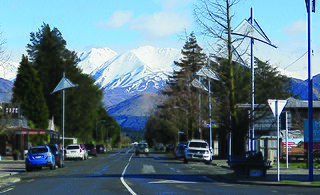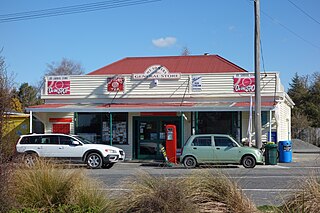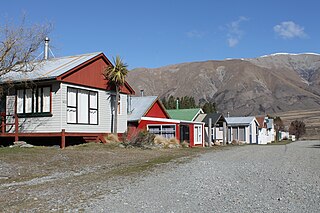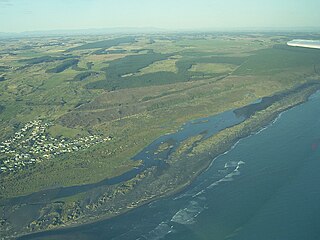
Marlborough District or the Marlborough Region, commonly known simply as Marlborough, is one of the 16 regions of New Zealand, located on the northeast of the South Island. Marlborough is a unitary authority, both a district and a region. Marlborough District Council is based at Blenheim, the largest town. The unitary region has a population of 52,200.

Ashburton is a large town in the Canterbury Region, on the east coast of the South Island of New Zealand. The town is the seat of the Ashburton District. It is 85 kilometres (53 mi) south west of Christchurch and is sometimes regarded as a satellite town of Christchurch.

Geraldine is a town in the Canterbury region in the South Island of New Zealand. It is about 140 km south of Christchurch, and inland from Timaru, which is 38 km to the south. Geraldine is located on State Highway 79 between the Orari and Hae Hae Te Moana Rivers and 45 kilometres to the east of Fairlie.

National Park is a small town on the North Island Central Plateau in New Zealand. Also known as National Park Village, it is the highest urban township in New Zealand, at 825 metres. The village has great views of Mount Tongariro, Mount Ngauruhoe, and Mount Ruapehu.

Bulls is a town in the Rangitikei District of New Zealand. It is in a fertile farming area at the junction of State Highways 1 and 3, 28 km (17 mi) northwest of Palmerston North. According to a June 2023 Statistics New Zealand estimate, Bulls has a population of 2,210 inhabitants.

Methven is a small town in the Canterbury region of the South Island of New Zealand. It is located near the western edge of the Canterbury Plains, 35 km (22 mi) north of Ashburton and 95 km (59 mi) west of Christchurch, and at an elevation of 320 m (1,050 ft). The town is a service centre for agriculture in the surrounding area, and is a base for skiing at the nearby Mount Hutt skifield. The town slogan is "Amazing Space".
Tinwald is a town in Canterbury, New Zealand, located approximately 3 kilometres south of Ashburton, from which it is separated by the Ashburton River / Hakatere. The town was named after Tinwald Downs in Scotland, birthplace of an early European resident and owner of much of the land, Robert Wilkin.

Mount Somers is a small town in Canterbury, New Zealand, nestled in the foothills of the Southern Alps. The population in the 2021 census was 160. Due to its scenic location, it has seen growth in the number of holiday homes.
Ashburton Forks, formerly known as Spreadeagle, is a defined locality on the Canterbury Plains between the forks of the Ashburton / Hakatere Rivers and within the Ashburton District of the Canterbury Province of New Zealand's South Island. It is approximately 50 km west of Ashburton and about 17 km from the foot of the Southern Alps.

Eiffelton is a lightly populated locality in the Mid-Canterbury region of New Zealand's South Island.

Joseph Ivess was a member of the New Zealand House of Representatives. He had an association with a large number of newspapers.
Wakanui was a rural parliamentary electorate in the south Canterbury region of New Zealand, from 1881 to 1887.

Ashburton District is a territorial authority district in the Canterbury Region of the South Island of New Zealand. It encompasses the town of Ashburton, a number of small towns and settlements and the surrounding rural area, roughly coterminous with Mid Canterbury. The district had a population of 36,800 as of June 2023.

Tahuna is a small rural settlement located 18 km north of Morrinsville. In the Māori language Tahuna means sandbank, likely to refer to the sandbanks along the nearby Piako River, where a Māori settlement started. Tahuna is seen as the upper limit for navigatable travel on the Piako River. The settlement has a rugby club, a lawn bowls club, a golf course and various shops.

Lake Clearwater is a village in the Ashburton District of New Zealand next to a lake of the same name. A basic camp ground is located between the village and the lake.

Koitiata is a settlement located in the southwestern part of Rangitikei District of the Manawatū-Whanganui region of New Zealand's North Island. At the time of the 2018 census, Koitiata had a population of 126. Marton is located 24 km to the east and Whanganui is located 29 km to the northwest. Nearby Koitiata is Lake Koitiata.

ANZCO Foods or simply ANZCO is a New Zealand meat producer fully owned by the Japanese company Itoham Foods, which in turn is part of Itoham Yonekyu Holdings. In 2016, ANZCO Foods was New Zealand's fifth-largest exporter, with a turnover of NZ$1.5b, and 3,000 employees.

Sir Graeme Thomas Harrison is a New Zealand business executive. He was the driving force behind ANZCO Foods, which is New Zealand's fifth-largest exporter. He was at the helm of ANZCO Foods for 34 years until his retirement in 2018.

Allenton is a suburb of Ashburton, in the Ashburton District and Canterbury Region of New Zealand's South Island.

Ashburton Central is the central suburb and central business district of Ashburton, in the Ashburton District and Canterbury Region of New Zealand's South Island.


















